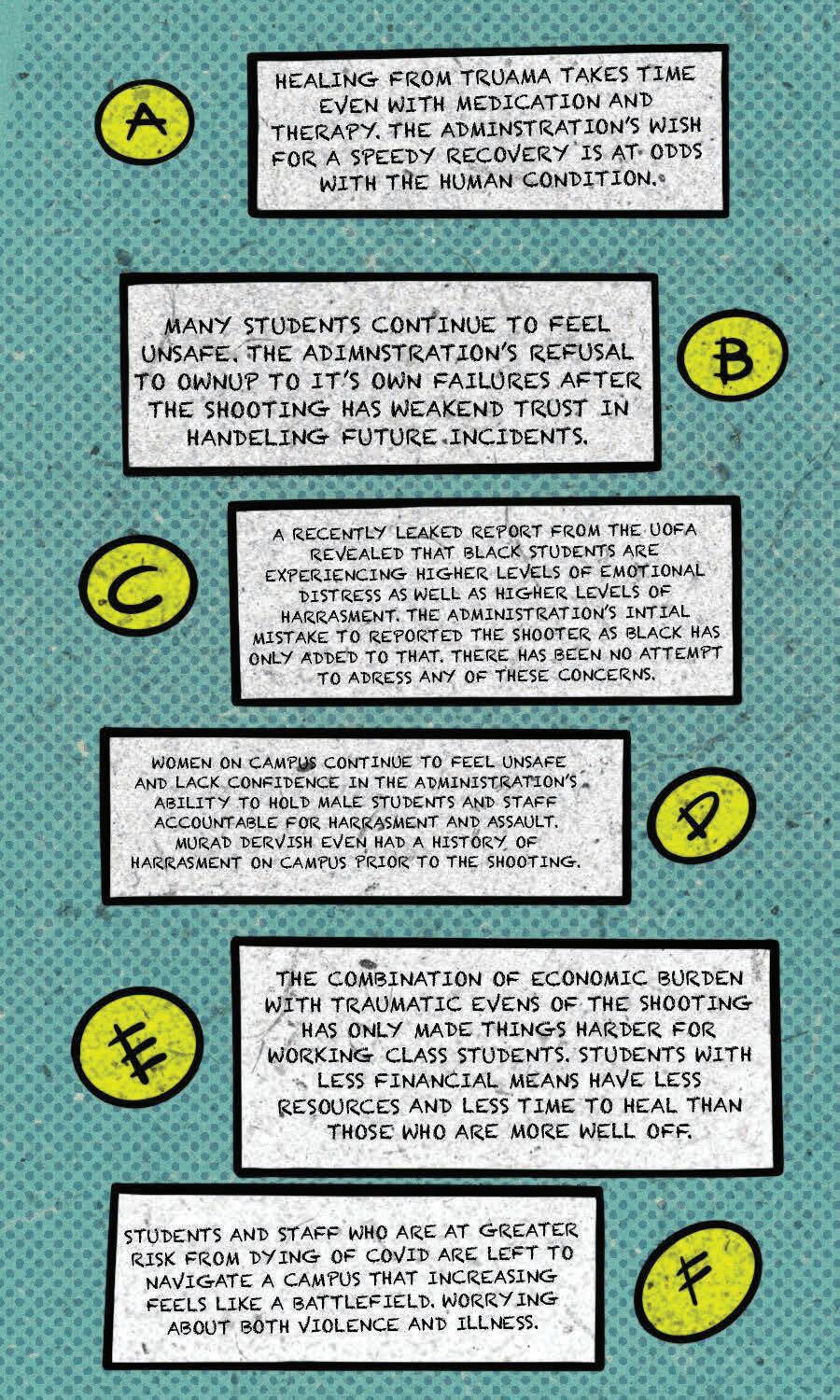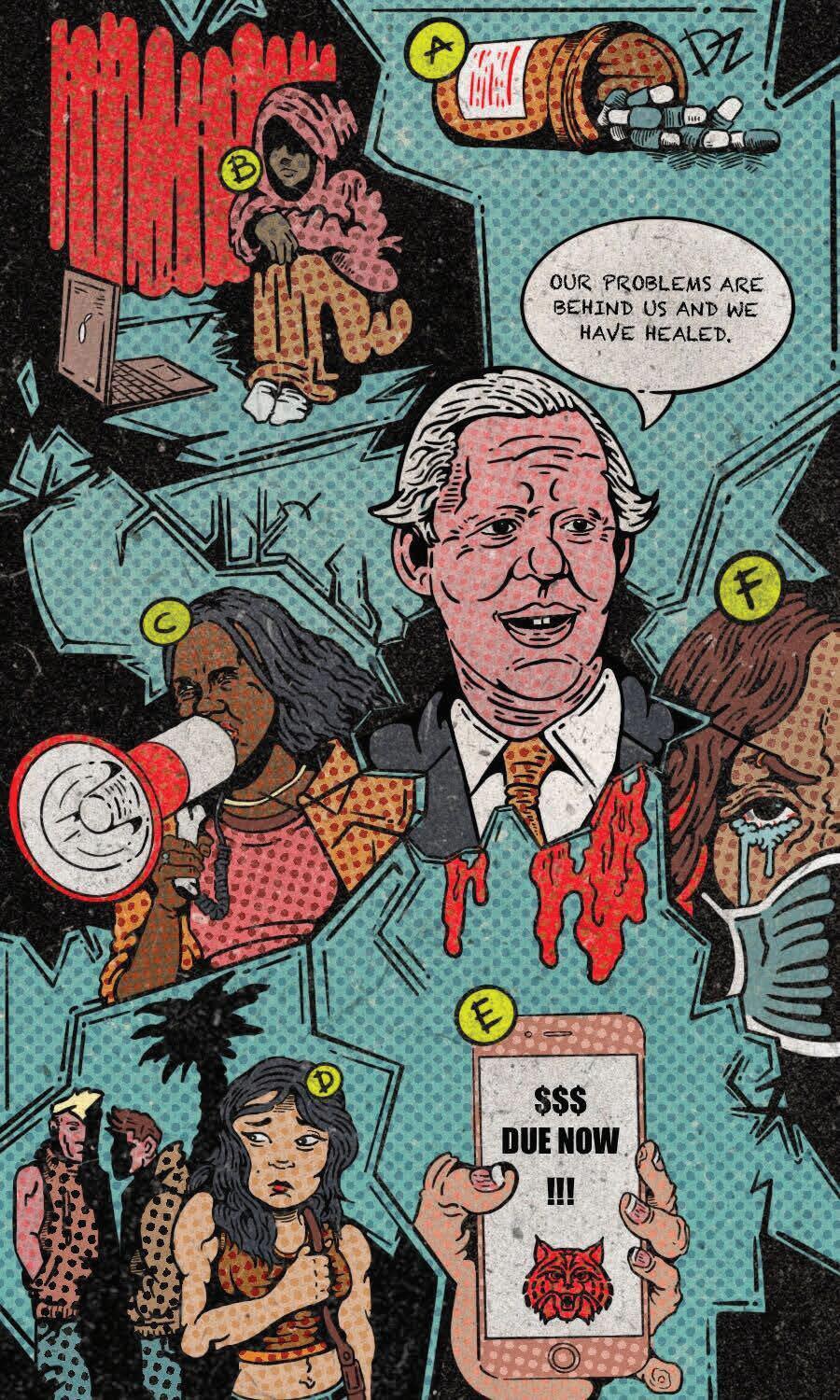
3 minute read
OPINION: The UA fails to help as toll on community’s mental health continues six months after campus shooting
many gain from the memorial’s presence to the perhaps daily reminder that can upset others as they grieve in their own ways.”
BY DIETZ @DailyWildcat
Since the shooting last semester, University of Arizona President Dr. Robert C. Robbins and the school’s administration have been focused on recovery and mental health — but this commitment often feels like lip service.
Healing from trauma takes an unknowable amount of time, even with medication and therapy. The administration’s wish for a speedy recovery is not only at odds with the human condition, but outright apathetic to it.
Insincerity
In November 2022, it was reported by KGUN news that the UA had removed a memorial for professor Thomas Meixner without consulting the Department of Hydrology and Atmospheric Sciences. When asked why it was taken down, the administration responded with, “best practices suggest that a month is a reasonable time to balance the comfort that
I do not believe there has been any significant report or study that has ever suggested community-made memorials have a negative effect on those communities. It seems more likely that the university did not want a public reminder of tragedy to taint the university’s image. This failure to be honest with students and faculty has led to an increased burden on campus mental health. Many students and faculty that I talk to continue to feel unsafe. Nobody seems to believe in any of Robbins’s promised changes. The administration’s refusal to own up to its own failures after the shooting has weakened trust in handling future incidents. This leaves students and faculty watching the continuing trend of school shootings with a heightened anxiety about their own safety.
Broken trust
A recently leaked report from the UA revealed that Black students are experiencing higher levels of emotional distress as well as higher levels of harassment. The UA only wishes to paint a picture of being a safe campus for diversity and inclusion, without engaging the accountability needed to make it a reality. The administration is aware their primary demographic is affluent white students and their messages of racial equality and acceptance is ultimately to soothe white guilt rather than assure Black students’ concerns.
Women on campus continue to feel unsafe and lack confidence in the administration’s ability to hold male students and staff accountable for harassment and assault. A young female opinions writer for the Daily Wildcat was harassed and threatened by male students. When she reported this to the Dean of Students office, the response was disorganized and delayed.
Murad Dervish, charged with the killing of Meixner, even had a history of harassment on campus months before the shooting, yet had no problem returning to campus with a weapon. Multiple complaints were made to the UA about this harassment, according to several Hydrology and
Atmospheric Sciences faculty members. Had the administration prioritized the safety by believing its own students and faculty when complaints are filed, then perhaps Dervish might not have had the opportunity to carry out his attack.
Lack of affordable resources
The combination of economic burdens with traumatic events has only made things harder for working class students. Students with less financial means have fewer resources and less time to heal than those who are more well-off. The UA’s Counseling and Psychological Services does not even accept AHCCCS, Arizona’s Medicaid service that provides insurance for those in financial need. There is also the fact that many adjunct professors do not make a substantial amount of money teaching classes that they now feel unsafe in. So both students and faculty facing financial troubles are left with few options.
It’s all about the money
The reason the university leaves its own campus community without support is likely because doing nothing looks like there is nothing wrong with campus culture as a whole, and campus culture is a major selling point to attracting new students.
Robbins and his administration may send out a slew of emails about mental health, healing as a community and creating a safe space, but at the end of the day, they are just emails.
Robbins was the former CEO of Texas Medical Center prior to running the show here at the University of Arizona and it shows. The school’s administration under him is heartlessly cold to the human needs in a way that feels distinctly corporate. Every mistake, every failure, has a clear profit motive no matter how much mental health is invoked as a rationale. Robbins is great for the school’s wallet but a heavy burden for the collective health of the campus.

— Dietz (they/them) is an illustration and design major at the University of Arizona School of Art. They love film, art and Karl Marx.











